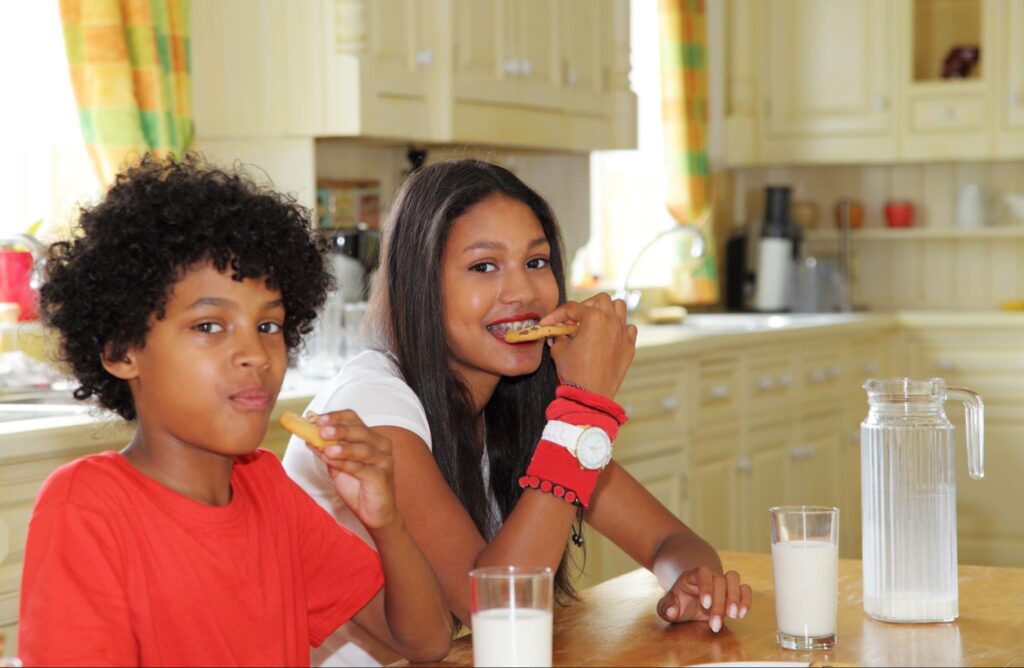Dr. Kanning knows you don’t want to avoid any foods with braces. And no one on our Kanning Orthodontics team blames you. We all have our favorite foods. Some of us like salty, crunchy snacks like peanuts, pretzels (and maybe even Cheetos). Others prefer sweet goodies like candy (don’t even get us started on dessert!). But when it comes to having braces, there are some foods you ought to avoid. That’s true at both our Kansas City and Liberty offices.
Keep Away From These Culinary Delights
Braces are your ticket to a straighter smile. But they come with a playbook of dietary dos and don’ts. Certain foods can threaten your braces. Eating them could potentially lead to damage and discomfort. Here’s a breakdown of the main culprits you should avoid to keep your treatment on track.
Hard Foods, Hard Times
Foods like ice, nuts, and hard candies might seem harmless. Under normal circumstances, they are. But when you have braces, think twice! Hard or crunchy foods can break your wires or dislodge your brackets. Hard foods demand caution. They can turn an ordinary meal into an emergency orthodontic visit.
Sticky Foods, Icky Situations
Sticky foods are a no-go for anyone with braces. Caramel, gummy candies, and even some chewing gums can stubbornly stick to your braces. These foods make your braces difficult to clean. Your braces don’t work well if they’re sticky. Why? Sticky foods can pull and damage the delicate components of your braces. If that happens, you might be headed for an unplanned orthodontic adjustment at either our Kansas City or Liberty office.
Chewy Foods
Chewy foods, including bagels, licorice, and thick pizza crusts, require a lot of force to chew. As a result, you might put unneeded strain on your braces. This stress can lead to broken brackets and wires. That’ll disrupt your treatment plan. For a safer alternative, look for softer, more braces-appropriate versions of your favorite foods that deliver the flavor without the risk.

The Consequences of Eating Prohibited Foods
Eating the wrong foods while wearing braces can cause immediate discomfort. But that’s not where your problems end. It can have lasting implications on your orthodontic treatment and overall oral health. We don’t want to scare anyone, but here’s what can happen if you don’t take Dr. Kanning’s advice.
Immediate Damage to Braces
We mentioned this above, but we need to repeat it. Hard or crunchy foods can easily break the brackets and bend the wires of your braces. This kind of damage might irritate your teeth or gums. If it gets too bad, you’ll end up in one of our chairs. While we love seeing you, we’d prefer it not to be under these circumstances.
Prolonged Treatment Time
If you break or dislodge components of your braces, they can no longer exert the necessary pressure to move your teeth. What’s wrong with that? If we have to repair your broken braces, your treatment might last longer. You may delay the moment when you finally see your new smile.
Increased Risk of Dental Problems
Foods that get stuck in your braces or are hard to clean off can lead to plaque build-up. Over time, you may increase your risk of cavities and gum disease. Translation: a longer time to complete your treatment. Certain foods and drinks, especially those that are dark or sugary, can stain around your brackets. This can leave you with uneven coloration on your teeth once the braces are removed.
General Discomfort
Sharp edges from broken brackets or wires can irritate the inside of your mouth. Damaged braces often make chewing painful or challenging, which can affect nutrition and meal enjoyment.
By avoiding prohibited foods, you not only protect your braces and ensure they work effectively, but you also maintain better oral hygiene and overall comfort throughout your orthodontic journey.

Safe Alternatives to Enjoy
Switching to foods safe for braces doesn’t mean you have to compromise on taste or variety. Plenty of delicious options will keep your braces secure and your taste buds happy. Soft fruits like bananas, berries, or citrus fruits like oranges are excellent for a sweet treat without the risk.
Steamed vegetables like carrots and broccoli provide a similar satisfaction for those who enjoy a crunchy texture. But they’re much gentler on your braces. Dairy products, particularly yogurt and soft cheeses, are safe and beneficial for their calcium content.
If you’re craving something more substantial, look for tender meats. Think chicken, turkey, or meatballs. They’re excellent protein sources that are easy on your braces. For a comforting meal, you can enjoy a variety of pasta and soft-cooked rice. These carbo-licious options are filling and braces-friendly.
When you want a snack, consider softer alternatives like muffins or soft tortillas rather than reaching for chips or pretzels. Remember to pick foods that require minimal biting force and won’t stick to your braces. With these alternatives, you can maintain a diverse and enjoyable diet while ensuring your orthodontic treatment remains on track.

Braces at Kanning Orthodontics
Understanding which foods are unfriendly keeps your progress moving as you go through your braces treatment. At Kanning Orthodontics in Kansas City and Liberty, Dr. Kanning wants your journey toward a perfect smile to be easy and free from unnecessary setbacks. By remembering which foods to avoid with braces, you can protect your smile’s future. Want to know more about our braces options? Visit us here to schedule your free consultation.



